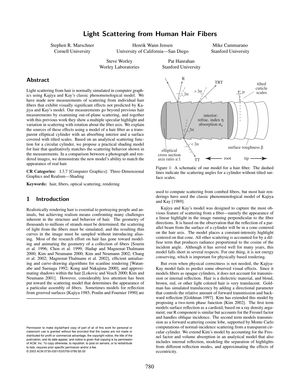Light scattering from human hair fibers
July 2003
in “ACM Transactions on Graphics”

TLDR Researchers developed a new model for more realistic computer graphics rendering of hair by considering how light scatters on hair fibers.
In 2003, researchers conducted a study on light scattering from human hair fibers, which led to the development of a new practical shading model for rendering hair in computer graphics. They discovered that the classic Kajiya and Kay model did not predict certain observed effects, such as multiple specular highlights and variations in scattering with the rotation of the hair fiber. The new model, based on a transparent elliptical cylinder with an absorbing interior and a surface of tilted scales, was able to qualitatively match the scattering behavior of real hair. The study involved detailed measurements using a four-axis goniometer and a CCD camera, and it accounted for surface reflection, transmission, and internal reflection, as well as the hair's elliptical cross-section and the tilt of cuticle scales. The model also considered the effects of hair fiber properties like roughness and cuticle scales, and it was filled in empirically for details not available from simple analysis. The researchers implemented the model in rendering software, producing images with 50,000-100,000 hair fibers, and suggested that for more realistic hair rendering, various scattering modes should be considered rather than relying on diffuse scattering alone. The findings have implications for both computer graphics and hair care product development.
View this study on doi.org →